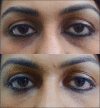Clinical Photography for Periorbital and Facial Aesthetic Practice
- PMID: 27398013
- PMCID: PMC4924408
- DOI: 10.4103/0974-2077.184047
Clinical Photography for Periorbital and Facial Aesthetic Practice
Abstract
External cutaneous photography involves photographic documentation, which helps in treatment planning, documentation of facial features, teaching, publishing and pre- and post-procedural comparisons. The key is not simply documenting, but documenting it the right way and ensuring that photography is standardised and reproducible. In this review, basic photography techniques, standardised and reproducible angles such as frontal, oblique and lateral views and specific photographic angles for conditions such as facial rejuvenation are discussed. Use of photography accessories and a few tips on how to click good photographs in the examination room and how to achieve consistency in standardised photography are also presented. External photography in ophthalmic and facial plastic surgery like any other speciality too has standardised guidelines. Even small variations cause a drastic change in the photos and it's clinical and research value. Unless stringent criteria are met, the photographs lose their relevance and impact.
Keywords: Aesthetics; camera; dermatology; documentation; facial photography; guidelines; photography; plastic surgery; standardization.
Figures







Similar articles
-
Photographic surgery: standards in clinical photography.Aesthetic Plast Surg. 1986;10(3):177-80. doi: 10.1007/BF01575289. Aesthetic Plast Surg. 1986. PMID: 3788730
-
Standardization in dental photography.Int Dent J. 1985 Sep;35(3):210-7. Int Dent J. 1985. PMID: 3863799
-
Principles and practice of external digital photography in ophthalmology.Indian J Ophthalmol. 2012 Mar-Apr;60(2):119-25. doi: 10.4103/0301-4738.94053. Indian J Ophthalmol. 2012. PMID: 22446907 Free PMC article.
-
Exploring the art of medical photography - an otolaryngologist's perspective.J Laryngol Otol. 2022 Dec;136(12):1148-1163. doi: 10.1017/S0022215121002668. Epub 2021 Oct 1. J Laryngol Otol. 2022. PMID: 34593064 Review.
-
Standardized photography for skin surface.Facial Plast Surg Clin North Am. 2011 May;19(2):241-6. doi: 10.1016/j.fsc.2011.04.001. Facial Plast Surg Clin North Am. 2011. PMID: 21763985 Review.
Cited by
-
Photodocumentation in oculoplastic surgery: an up-to-date overview.Arq Bras Oftalmol. 2022 Sep-Oct;85(5):V-XIV. doi: 10.5935/0004-2749.2021-0318. Arq Bras Oftalmol. 2022. PMID: 36228239 Free PMC article. No abstract available.
-
Smartphone use by government dermatology practitioners in Kuwait: a self-reported questionnaire based cross-sectional study.BMC Med Inform Decis Mak. 2019 Aug 5;19(1):155. doi: 10.1186/s12911-019-0883-z. BMC Med Inform Decis Mak. 2019. PMID: 31382971 Free PMC article.
-
The Patient Journey in Facial Aesthetics: Findings from a European Consensus Meeting on Improving the Quality of Life for Patients Receiving Botulinum Toxin Injections.Clin Cosmet Investig Dermatol. 2024 Feb 2;17:329-337. doi: 10.2147/CCID.S446891. eCollection 2024. Clin Cosmet Investig Dermatol. 2024. PMID: 38327550 Free PMC article.
-
Patient perceptions regarding the use of smart devices for medical photography: results of a patient-based survey.Int Ophthalmol. 2019 Apr;39(4):783-789. doi: 10.1007/s10792-018-0878-2. Epub 2018 Mar 6. Int Ophthalmol. 2019. PMID: 29511959
-
Quantitative Assessment of Hyperpigmentation Changes in Human Skin after Microneedle Mesotherapy Using the Gray-Level Co-Occurrence Matrix (GLCM) Method.J Clin Med. 2023 Aug 11;12(16):5249. doi: 10.3390/jcm12165249. J Clin Med. 2023. PMID: 37629289 Free PMC article.
References
-
- Khavkin J, Ellis DA. Standardized photography for skin surface. Facial Plast Surg Clin North Am. 2011;19:241–6. - PubMed
-
- Sommer DD, Mendelsohn M. Pitfalls of nonstandardized photography in facial plastic surgery patients. Plast Reconstr Surg. 2004;114:10–4. - PubMed
-
- Neff LL, Humphrey CD, Kriet JD. Setting up a medical portrait studio. Facial Plast Surg Clin North Am. 2010;18:231–6. - PubMed
-
- Shah AR, Dayan SH, Hamilton GS., 3rd Pitfalls of photography for facial resurfacing and rejuvenation procedures. Facial Plast Surg. 2005;21:154–61. - PubMed
LinkOut - more resources
Full Text Sources
Other Literature Sources
Miscellaneous

